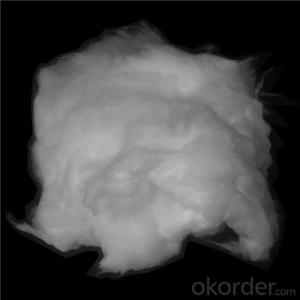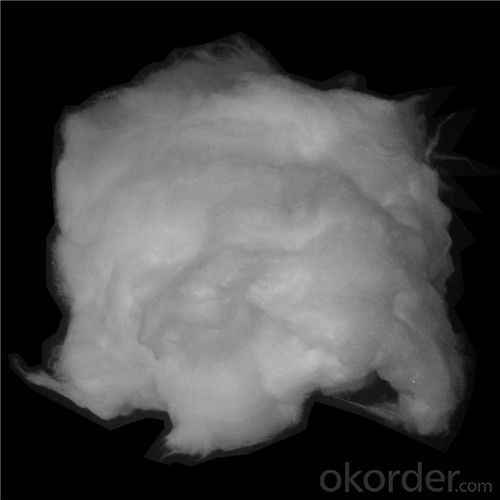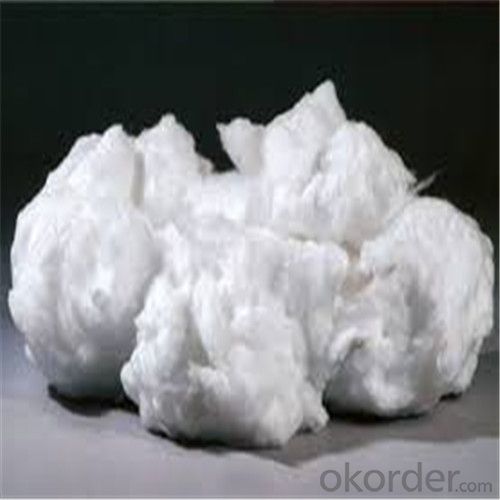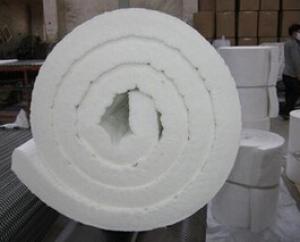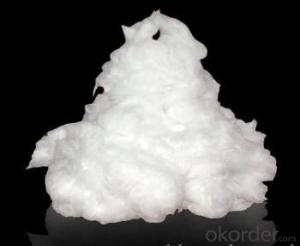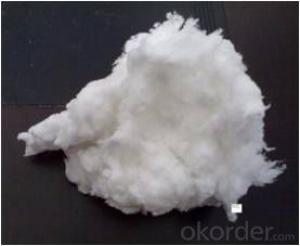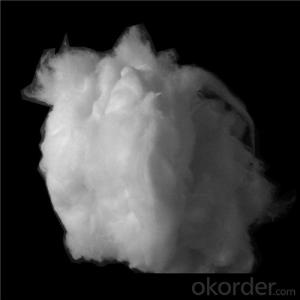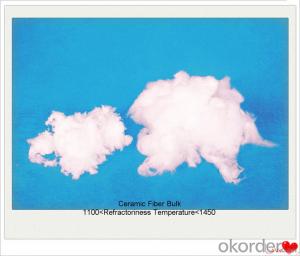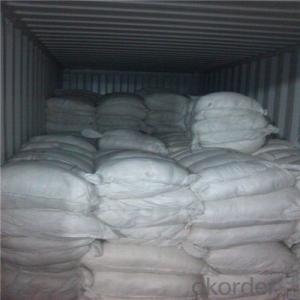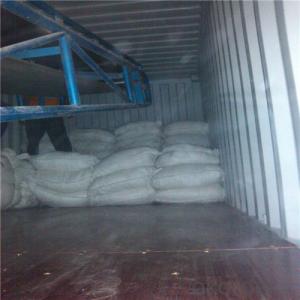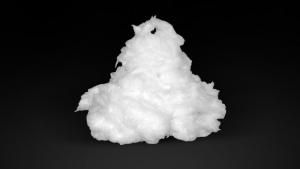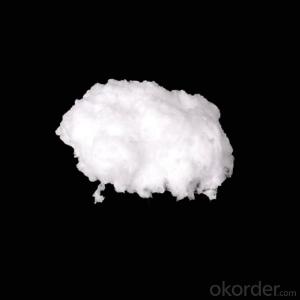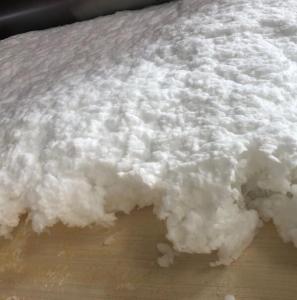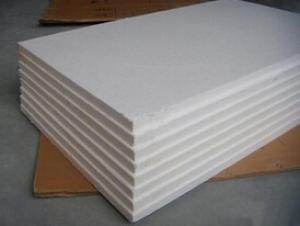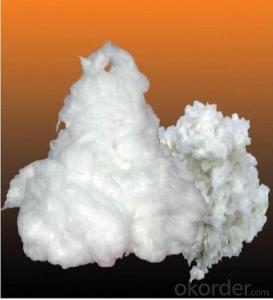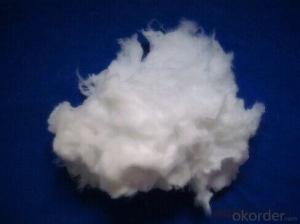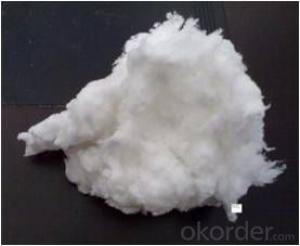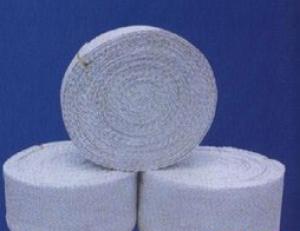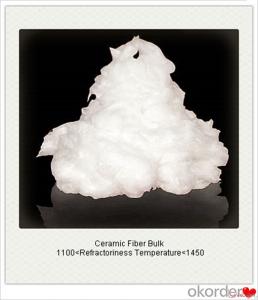Ceramic Fiber Bulk - High Quality Supplier in China
- Loading Port:
- Qingdao
- Payment Terms:
- TT OR LC
- Min Order Qty:
- 1 m.t.
- Supply Capability:
- 10000000 m.t./month
OKorder Service Pledge
OKorder Financial Service
You Might Also Like
Ceramic fiber bulk is made by the melted raw materials at high temperature through resistance furnace, before being blown or spun into fiber. As a neutral and acidic material, except reaction with the strong acid-alkali, ceramic fiber won’t be eroded by other weak alkali, weak acids, or water, oil, steam, or be infiltrated with lead, aluminum or copper, featuring excellent flexibility and elasticity.
Ceramic fiber is of smaller density, more than 75% lighter than insulation brick lining or 90% -95% lighter than lightweight castable lining, with thermal conductivity co-efficient to be 1/8 of the lightweight clay brick or 1/10 of lightweight heat-resistant lining (castable), and heat capacity to be 1/10 of both lightweight insulation lining and lightweight castable lining, thus to greatly lower energy loss and deliver significant energy-saving regenerative effects. Meanwhile, the ceramic fiber features a simple construction with no need of baking oven, shortened construct
es of Products | Ceramic Fiber Blown Bulk | Ceramic Fiber Spun Bulk | Other Ceramic Fiber | |||||||||
1260 Stand ard Ceramic Fiber Bulk | 1400 High-purity Ceramic Fiber Bulk | 1050 Ordinary Ceramic Fiber Bulk | 1260 Stand ard Ceramic Fiber Bulk | 1260 High-purity Ceramic Fiber Bulk | 1450 Zirconia Ceramic Fiber Bulk | Ceramic Fiber Textile | Ceramic Fiber Friction Material | Grain Ceramic Fiber | ||||
| (kg/m3) | 2.73g/cm3 | 2.73 g/cm3 | 2.67 g/cm3 | 2.73 g/cm3 | ||||||||
| Density | ||||||||||||
| (µm) | 2.0-4.0 | 3.0-5.0 | 3.0 -5.0
| 2.0 -4.0 | ||||||||
| Mean Fiber Diameter | ||||||||||||
| (%) | ≤22 | ≤20 | ≤22 | ≤22 | ≤20 | ≤18 | ≤15 | ≤22 | ≤18 | |||
| ≥0.212mm | ||||||||||||
| Shot Content | ||||||||||||
| (%) | - | - | - | - | - | - | ≤3 | - | ||||
Water Coontent | ||||||||||||
Non-fiber Substances (weight %) | - | - | - | - | - | - | ≤35 | - | ||||
| (µm) | - | - | - | - | - | - | - | 150 | ≤20 | |||
| Fiber Length | ||||||||||||
Chemical Composi tion | Al2O3 (%) | ≥45 | ≥53 | ≥44 | ≥45 | ≥45 | ≥36 | ≥45 | ||||
| SiO2 (%) | ≥52 | ≥46 | ≥52 | ≥52 | ≥54 | ≥48 | ≥52 | |||||
| ZrO2 (%) | - | - | - | - | - | ≥15 | - | |||||
| Fe2O3 (%) | ≤0.8 | ≤0.2 | ≤1.0 | ≤0.8 | ≤0.2 | ≤0.1 | ≤0.8 | |||||
Al2O3 +SiO2 (%) | ≥97 | ≥99 | ≥96 | ≥97 | ≥99 | - | ≥97 | |||||
Al2O3 +SiO2 +ZrO2 (%) | - | - | - | - | 99 | - | ||||||
| Packing | Braided Bag | |||||||||||

What is the Typical Applications of Ceramic Fiber Bulk?
Ceramic fiber bulk for textile manufacture
Expansion joint packing
Wet process feedstock
Filtration media
Kiln car infill
Moldables / Mastics feedstock
Ladle insulation
FAQ
A1: With strict quality control system throughout the materials selection and production process, our refractory and ceramic fiber products quality is effectively controlled to meet customer requirements.
From the raw materials selecting, our quality control begin. The quality certificates of raw materials are required and each batch will be tested before using. During production, the quality control is conducted by workers and then each piece will be sorted and examined by quality supervisors.
Q2: What`s the lead time for my order?
A2: It depends on customers’ requirements and our production schedule. And usually we need 30-60 days for refractory bricks, 10-25 days for unshaped refractory materials and 10-20 days for ceramic fiber blankets.
- Q: What are the main differences between an ordinary furnace and a ceramic fiber furnace?
- The main difference between ordinary furnace and ceramic fiber furnace:Refractory, heat insulation: ceramic fiber furnace low thermal conductivity, low thermal conductivity, is a better thermal insulation materials, the use of temperature within one thousand and three hundred Baidu. The heat conductivity of common furnace is higher and the heat loss is great
- Q: What is the density of ceramic fiber modules? The best insulation effect
- Ceramic fiber module density is only a standard in the world, is 220Kg/m fand, but in the actual application, according to the heat treatment furnace, furnace temperature, combustion medium, temperature rise requirement of ceramic fiber module density in 200-240Kg/m fand, ceramic fiber blanket, because the processing of ceramic fiber module uses double roller today advanced technology and technology of silk, fiber length of the ceramic fiber blanket which produced in 80-130 mm, so the maximum density of the ceramic fiber module is more than the density, 240Kg/m fand, a large amount of fiber fracture, the fracture rate is as high as 48%. So after the actual verification at home and abroad of tens of thousands of industrial furnaces, the best density of ceramic fiber module is fand 220Kg/m.
- Q: Should the ceramic fiber furnace be compacted?
- In view of the miniature furnace chamber, the ceramic fiber furnace can be selected, and once the furnace is formed, the length of the furnace is longer.
- Q: Glass fiber cotton, aluminum silicate cotton, rock wool, what's the difference between these three?
- Name: Cotton aluminosilicate ceramic fiber cotton, is an almost pure inorganic fiber, formed by blowing process production process or thrown silk spray, is a kind of low thermal conductivity, low heat capacity; high strength, high tear resistance, excellent machining performance. Aluminum silicate insulation material has become the best industrial furnace lining wall insulation materials, completely replace refractory bricks.
- Q: Aluminum silicate ceramic fiber cotton smoke will cause pneumoconiosis?
- Most of the aluminosilicate ceramic fiber cotton with high quality bauxite, high purity alumina, silica, zircon sand as raw materials, by blowing or swinging method generated by fiber, cotton collector or settlement device assembled into bulk fiber, also known as cotton fiber. Therefore, according to its composition, after inhalation, will lead to pneumoconiosis.
- Q: Is the ceramic fiber cloth poisonous?
- With aluminum, zinc and other non-ferrous molten metal erosion capacity. Excellent high temperature strength. The bottom heat conductivity makes the product have good heat insulation performance. Excellent electrical insulation performance. Non-toxic, harmless, no adverse effects on the environment, excellent tensile properties.
- Q: What is the diameter of the ceramic fiber? How to mix?
- Fiber diameter: rejection fiber more coarse, rejection fiber generally 3.0-5.0 - m, spinneret fiber is generally 2.0-3.0 - m;
- Q: What is the good heat insulation effect of glass fiber and aluminum silicate fiber, what are their respective advantages and disadvantages?
- Adiabatic effect: glass fiber thermal conductivity at room temperature was about 0.056, the thermal conductivity at room temperature is about 0.035, due to the lower thermal conductivity, moisturizing effect is better, so the material characteristics of aluminum silicate fiber insulation effect is good, but also with the insulation effect of fiber compression density, can not be generalized.
- Q: Aluminum silicate needle carpet and ceramic fiber insulation performance of the good
- Aluminum silicate needle carpet should be aluminum silicate needled blanket, with the continuous production, by acupuncture fiber uniformity, high tensile strength, does not contain any additives. Ceramic fiber, also known as aluminum silicate fiber, is only a different name.
- Q: Ceramic fiber material fire shutter door how many square?
- There is no full ceramic fiber material fire shutter;
Send your message to us
Ceramic Fiber Bulk - High Quality Supplier in China
- Loading Port:
- Qingdao
- Payment Terms:
- TT OR LC
- Min Order Qty:
- 1 m.t.
- Supply Capability:
- 10000000 m.t./month
OKorder Service Pledge
OKorder Financial Service
Similar products
Hot products
Hot Searches
